
Sutro Baths
Encyclopedia
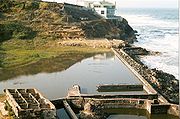
California
California is a state located on the West Coast of the United States. It is by far the most populous U.S. state, and the third-largest by land area...
, built in the late 19th century. The building housing the baths burned down in 1966 and was abandoned. The ruins may still be visited.
History
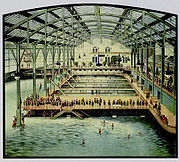
Adolph Sutro
Adolph Heinrich Joseph Sutro was the 24th mayor of San Francisco, and second Jewish mayor, serving in that office from 1894 until 1896...
. The vast glass, iron, wood, and reinforced concrete structure was mostly hidden, and filled a small beach inlet below the Cliff House
Cliff House, San Francisco
The Cliff House is a restaurant perched on the headlands on the cliffs just north of Ocean Beach on the western side of San Francisco, California...
, also owned by Adolph Sutro at the time. Both the Cliff House and the former baths site are now a part of the Golden Gate National Recreation Area
Golden Gate National Recreation Area
The Golden Gate National Recreation Area is a U.S. National Recreation Area administered by the National Park Service that surrounds the San Francisco Bay area. It is one of the most visited units of the National Park system in the United States, with over 13 million visitors a year...
and operated by the United States National Park Service
National Park Service
The National Park Service is the U.S. federal agency that manages all national parks, many national monuments, and other conservation and historical properties with various title designations...
.
A visitor to the baths not only had a choice of seven different swimming pools—one fresh water and six salt water baths ranging in temperatures—but could also visit a museum displaying Sutro's large and varied personal collection of artifacts from his travels, a concert hall, seating for 8,000, and, at one time, an ice skating rink. During high tides, water would flow directly into the pools from the nearby ocean, recycling the two million US gallons (7,600 m³) of water in about an hour. During low tides, a powerful turbine water pump, built inside a cave at sea level, could be switched on from a control room and could fill the tanks at a rate of 6,000 US gallons a minute (380 L/s), recycling all the water in five hours.
The baths were once serviced by a rail line, the Ferries and Cliff House Railroad, which ran along the cliffs of Lands End overlooking the Golden Gate
Golden Gate
The Golden Gate is the North American strait connecting San Francisco Bay to the Pacific Ocean. Since 1937 it has been spanned by the Golden Gate Bridge...
. The route ran from the baths to a terminal at California Street and Central Avenue (now Presidio Avenue).
The baths struggled for years, mostly due to the very high operating and maintenance costs. Shortly after closing, a fire in 1966 destroyed the building while it was in the process of being demolished. All that remains of the site are concrete walls, blocked off stairs and passageways, and a tunnel with a deep crevice in the middle. The Sutro Bath ruins are open to the public, but a warning sign advises strict caution, as visitors have been swept off by large waves and drowned at the site.
Currently, visitors coming to the Sutro Baths from the above parking lot are presented with a sign that describes the history of Sutro Baths starting from its construction and glamorous opening to the public in 1896. Another sign describes the later years of the site's history up until its demolition and complete destruction by fire in 1966. As one walks up out of the ruins toward the historic Cliff House, home to two full service restaurants: "Sutro’s at the Cliff House" and "The Bistro", as well as the "Terrace Room", a private Dining/reception room, one can find other pictures, paintings, and relics from the golden age of Sutro Baths’ functional operation.
Seal Rock is just offshore from the bath ruins.
Footage preserved by the Library of Congress
Several films are stored by the Library of Congress as part of the American Memory collection and available for viewing online.- Sutro Baths, no. 1 and Sutro Baths, no. 2, filmed in 1897 by Thomas A. Edison, Inc.
- Panoramic view from a steam engine on the Ferries and Cliff House Railroad line route along the cliffs of Lands End, starting at the Sutro Baths depot, filmed in 1902 by Thomas A. Edison, Inc.
- Panoramic view from the beach below Cliff House at Sutro Baths, filmed in 1903 by American Mutoscope and Biograph Company.
The Lineup (1958)
The 1958 film The LineupThe Lineup (film)
The Lineup is a 1958 American film version of the police procedural series that ran on CBS radio from 1950 through 1953 and on CBS television from 1954 through 1960, directed by Don Siegel...
was the only non-documentary film to use the fully built baths as a shooting location. The scenes were shot after Sutro Baths' conversion to an ice skating rink.
Harold and Maude (1971)
The baths are featured in a scene in the 1971 film Harold and MaudeHarold and Maude
Harold and Maude is a 1971 American dark comedy film directed by Hal Ashby and released by Paramount Pictures. It incorporates elements of dark humor and existentialist drama, with a plot that revolves around the exploits of a young man intrigued with death, Harold...
in which Harold pretends to assault Maude while she acts the part of a war protester, in order to convince Harold's uncle (a high-ranking military man) that he is unfit for service. Maude "falls" down a hole in the ground and disappears after Harold grabs her protest sign and chases her with it, striking her and calling her various names such as "Commie!"
Sutro's: The Palace at Lands End (2011)
This documentary by Tom Wyrsch includes footage and photographs of the Baths, Sutro Railway, Cliff House, ice skating rink, Egyptian Mummy Museum, Musee Mecanique, and the Giggling Ghost.Bath statistics
Statistics according to a 1912 article written by J. E. Van Hoosear of Pacific Gas and Electric.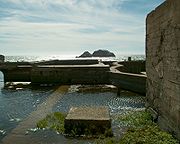
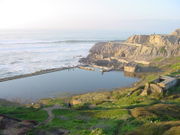
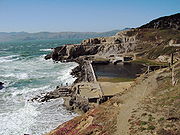
- Length of baths: 499.5 feet (152.2 m)
- Width of baths: 254.1 feet (77.4 m)
- Amount of glass used: 100000 sq ft (9,290.3 m²)
- IronIronIron is a chemical element with the symbol Fe and atomic number 26. It is a metal in the first transition series. It is the most common element forming the planet Earth as a whole, forming much of Earth's outer and inner core. It is the fourth most common element in the Earth's crust...
in roof columns: 600 tons - Lumber: 3500000 board feet (8,259.1 m³)
- Concrete: 10000 cu yd (7,645.5 m³)
- Seating capacitySeating capacitySeating capacity refers to the number of people who can be seated in a specific space, both in terms of the physical space available, and in terms of limitations set by law. Seating capacity can be used in the description of anything ranging from an automobile that seats two to a stadium that seats...
, amphitheater: 3,700 - Seating capacitySeating capacitySeating capacity refers to the number of people who can be seated in a specific space, both in terms of the physical space available, and in terms of limitations set by law. Seating capacity can be used in the description of anything ranging from an automobile that seats two to a stadium that seats...
, promenade: 3,700 - Holding capacity: 25,000
- Salt waterSeawaterSeawater is water from a sea or ocean. On average, seawater in the world's oceans has a salinity of about 3.5% . This means that every kilogram of seawater has approximately of dissolved salts . The average density of seawater at the ocean surface is 1.025 g/ml...
tanks: 6 - Capacity of tanks: 1805000 gallons (6,832.7 m³)
- Fresh water, plunge tank: 1
- TobogganTobogganA toboggan is a simple sled which is a traditional form of transport used by the Innu and Cree of northern Canada. In modern times, it is used on snow to carry one or more people down a hill or other slope for recreation. Designs vary from simple, traditional models to modern engineered composites...
slides in baths: 7 - Swinging rings: 30
- Spring boards: 1
- Private dressing rooms: 517
- Club rooms capacity: 1,110
- Time required to fill tank by high tide: 1 hour
- Time required to fill tank by pump: 5 hours
See also
- Lurline BathsLurline BathsThe Lurline Baths were public salt water baths built in 1894 in San Francisco, California at the corner of Bush and Larkin streets. The Lurline Baths closed in 1936. The Lurline Pier at Ocean Beach between Anza and Balboa Streets, was built to protect the intake pipe which provided seawater to the...
- 49-Mile Scenic Drive49-Mile Scenic DriveThe 49-Mile Scenic Drive in San Francisco highlights many of the city's major attractions and historic structures.Opened on September 14, 1938 as a promotion for the 1939 Golden Gate International Exposition, it...
- Sutro's: The Palace at Lands End
Sutro Baths then
- Comprehensive history of the Sutro Baths (Western Neighborhoods website)
- Photos of Sutro Baths from the San Francisco Historical Photograph Collection (San Francisco Public Library)
- Over 100 photos taken at the Sutro Baths, including interiors not seen at any other links and pictures taken immediately before, during, and after the fire.
Sutro Baths now
- Sutro Bath and Cliff House page at the National Park Service website
- A fantastic starting point for all things related to the Sutro Baths
- Current home of the Egyptian art exhibit formerly located at the Sutro Baths
- An online posting by a relative of the last owners of the Sutro Baths, and sheds a little light on the fire that destroyed it in 1966

